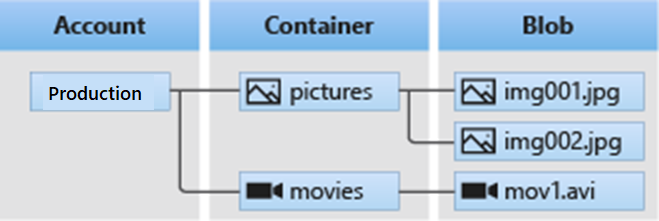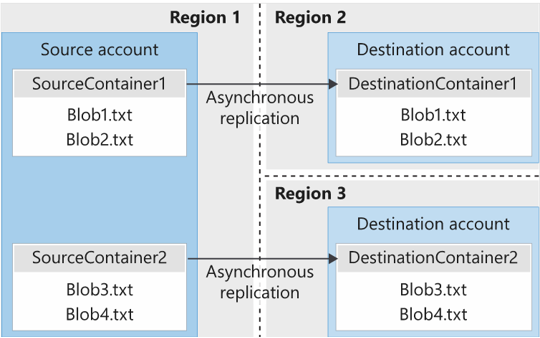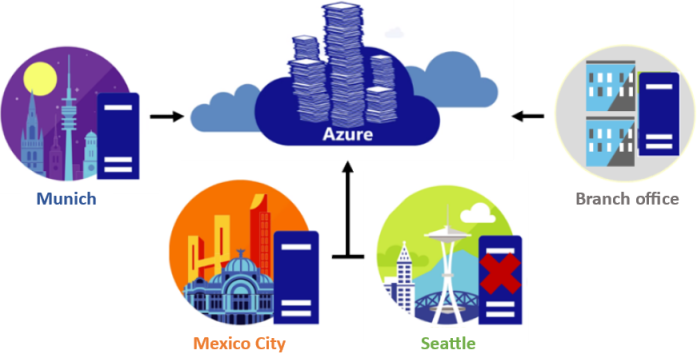Question
Time left
Score
0
What is the answer to this questions?
A
Choice 1
B
Choice 2
C
Choice 3
D
Choice 4
Below are some resources for Implementing and Managing Storage:
1
Suppose you have two video files stored as blobs. One of the videos is business-critical and requires a replication policy that creates multiple copies across geographically diverse datacenters. The other video is non-critical, and a local replication policy is sufficient. Which of the following options would satisfy both data diversity and cost sensitivity consideration.
- Create two storage accounts. The first account makes use of Geo-redundant storage (GRS) and hosts the business-critical video content. The second account makes use of Local-redundant storage (LRS) and hosts the non-critical video content.
- In general, increased diversity means an increased number of storage accounts. A storage account by itself has no financial cost. However, the settings you choose for the account do influence the cost of services in the account. Use multiple storage accounts to reduce costs.
2
The name of a storage account must be:
- Globally unique.
- The storage account name is used as part of the URI for API access, so it must be globally unique.
3
In a typical project, when would you create your storage account(s)?
- At the beginning, during project setup.
- Storage accounts are stable for the lifetime of a project. It's common to create them at the start of a project.
4
Which storage type replicates data to a secondary region, maintain six copies of the data, and is the default replication option?
- Read-access geo-redundant storage
- Read-access geo-redundant storage is the default replication option. Geo-redundant storage (GRS) copies the data synchronously three times within a single physical location in the primary region using LRS. It then copies the data asynchronously to a single physical location in the secondary region.
5
The name of a storage account must be -------------
- Globally unique
- The storage account name is used as part of the URI for API access, so it must be globally unique.
6
A manufacturing company has sensors that record time-relative data. Only the most recent data is useful. The company wants the lowest cost storage for this data. What is the best storage account for the company?
- Locally redundant storage
- Tt's the lowest cost, the data is being continuously created, and data loss isn't an issue.
7
What is Storage Explorer?
- Storage Explorer is a GUI application developed by Microsoft to simplify access to, and the management of, data stored in Azure storage accounts. Storage Explorer is available on Windows, macOS, and Linux.
-
8
What are Azure Storage types?
- Azure Blob Storage. Blob storage is used to store unstructured data as a binary large object (blob).
- Azure Table Storage. Table storage is used to store NoSQL, semi-structured data.
- Azure Queue Storage. Queue storage is used to store messages in a queue, which can then be accessed and processed by applications through HTTP(S) calls.
- Azure Files. Azure Files is a file-sharing service that enables access through the Server Message Block protocol, similar to traditional file servers.
- Azure Data Lake Storage. Azure Data Lake, based on Apache Hadoop, is designed for large data volumes and can store unstructured and structured data.
9
When configuring network access to an Azure Storage Account, what is the default network rule?
- The default network rule is to allow all connections from all networks.
-
10
A company is planning a delegation model for the Azure storage. Apps in the production environment must have unrestricted access to storage resources. Which is the best course of action?
- Use access keys for the production apps
- Access keys provide unrestricted access to the storage resources, which is the requirement for production apps in this scenario.
11
Explain Azure Service Fabric
- Azure Service Fabric is a distributed platform designed by Microsoft to facilitate the
development, deployment and management of highly scalable and customizable applications.
The applications created in this environment consists of detached microservices that
communicate with each other through service application programming interfaces.
12
Define the Azure Redis Cache.
- Azure Redis Cache is an open-source and in-memory Redis cache that helps web applications
to fetch data from a backend data source into cache and server web pages from the cache to
enhance the application performance. It provides a powerful and secure way to cache the
application’s data in the Azure cloud.
13
How many instances of a Role should be deployed to satisfy Azure SLA (service
level agreement)? And what’s the benefit of Azure SLA?
- TWO. And if we do so, the role would have external connectivity at least 99.95% of the time.
14
What are the options to manage session state in Windows Azure?
- Windows Azure Caching
- SQL Azure
- Azure Table
15
What is cspack?
- It is a command-line tool that generates a service package file (.cspkg) and prepares an
application for deployment, either to Windows Azure or to the compute emulator
16
What is csrun?
- It is a command-line tool that deploys a packaged application to the Windows Azure compute
emulator and manages the running service.
17
How does the Azure VM backup work?
- Azure Backup introduces a reinforcement expansion to the Azure VM specialist that is running on the VM. This expansion backs up the whole VM. You can back up explicit records and organizers on the Azure VM by running the MARS operator.
- Reference: Azure VM Backup
18
How to resize my Azure VM?
- How to resize a Linux VM with the Azure CLI - Azure Linux Virtual Machines az vm resize --resource-group mygroup --name mytestvm --size Standard_D4s_v3 This call would trigger instance restart in the background if needed.
19
ou need to create an Azure storage solution that will store messages created by an Azure web role. The messages will then be processed by an Azure worker role. What type of storage solution should you create?
- Azure Queue storage is a service for storing large numbers of messages that can be accessed from anywhere in the world via authenticated calls using HTTP or HTTPS.
- Reference: Azure Queue storage
20
You are deploying a pair of Azure virtual machines. You want to ensure that the application will remain available in the event of a complete data center failure. What Azure technology will help most in this task?
- An Availability zone consists of two or more virtual machines in different physical locations within an Azure region. This configuration ensures that only a subset of the virtual machines in an availability zone will be affected in the event of hardware failure, OS update, or a complete data center outage. This configuration offers 99.99% SLA.
- Reference: Azure Administrator Exam Prep Blog
Azure Administrator AZ104 Certification Exam Preparation
Azure Storage Illustration Slideshow
Below are the skills measured in this category:
Implement and manage storage (15–20%)
1
Secure storage
- configure network access to storage accounts
- create and configure storage accounts
- generate shared access signature (SAS) tokens
- manage access keys
- configure Azure AD authentication for a storage account
- configure access to Azure Files
2
Manage storage
- export from Azure job
- import into Azure job
- install and use Azure Storage Explorer
- copy data by using AZCopy
- implement Azure Storage replication
- configure blob object replication
3
Configure Azure files and Azure Blob Storage
- create an Azure file share
- create and configure Azure File Sync service
- configure Azure Blob Storage
- configure storage tiers for Azure Blob Storage
- configure blob lifecycle management









